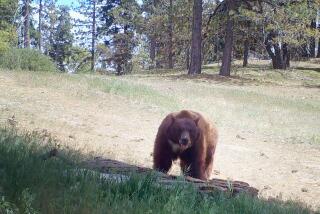Jungle route planning? There’s an ape for that
They’re not exactly logging onto Travelocity, but great apes appear to plan their travel, a study of Sumatran orangutans suggests.
Anthropologists at the University of Zurich suggest that the resonating “long calls” made by sexually mature male orangutans are directed toward where they are going to go as much as 22 hours later – they may be warning adversaries and tipping off friends, kin and mates to their future position.
“Our study makes it clear that wild orangutans do not simply live in the here and now, but can imagine a future and even announce their plans,” said anthropologist Carel van Shaik, lead author of the study published Wednesday in the online journal PLOS One. “In this sense, then, they have become a bit more like us.”
Over a period of five years, researchers chronicled 1,169 “long calls” from 15 male flanged orangutans on 320 days, then charted their movements. Sexually mature male orangutans have flanged throat pads that enable them to make such calls, which can be heard at a distance of more than half a mile through the dense forest canopy. Observation has shown the calls identify the individual males, repel males of lower rank and attract mates.
An evening long call predicted the direction of the male’s travel the next day, and further calls during the travel day also correlated with his direction of travel, the study found. Females, for their part, appeared to follow the calls and come closer to the males, according to the report.
The researchers did not address the mechanisms responsible for the behaviors, and therefore cannot answer key questions about how primates might put together such routes. But planning requires both episodic memory and self-control, among other complex functions, they noted. A zoo monkey caching stones for use against future visitors is but one example, they wrote.
More controlled experiments have been just as revealing. Chimpanzees, orangutans and bonobos have shown the ability to choose, store and transport tools for use hours later.
A study that followed 11 spider monkeys in Mexico’s Yucatan peninsula suggested that they used spatial memory to help them choose optimal routes. Capuchin monkeys in another study appeared to make trade-offs between distance and such factors as productivity or uniqueness of these locations.
Baboon studies have been somewhat split, with one suggesting their daily forage trips appeared to be efficient and goal-directed, while another suggested foraging was far more improvised, with only a rudimentary sense of routes toward a few fruit trees.
Earlier this year, a long-term study of chimpanzees and orangutans suggested they remembered where to find tools that would help them get a banana or frozen yogurt, three years after being exposed to the task just four times. The apes also were able to remember a similar scenario from two weeks earlier, even though it was presented only once, the researchers found. Whether such autobiographical memory can be employed in planning, though, was not tested.
So, the question of whether our primate cousins plan their day remains open until apes use apps.







